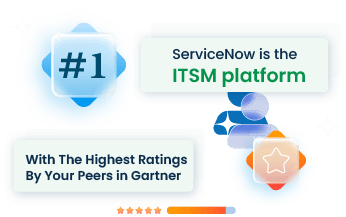“C-level executives struggle to proactively address business challenges and make data-driven decisions in today’s fast-paced market. Missed opportunities, operational inefficiencies, and reactive problem-solving hinder growth and profitability.
ServiceNow Predictive Intelligence empowers C-level executives with AI-driven insights and predictive capabilities to anticipate needs, optimize processes, and drive informed decision-making.
Gain a competitive edge, streamline operations, and unlock new growth potential through proactive problem-solving and data-driven strategies. In this blog, we will explore how ServiceNow Predictive Intelligence can transform your business and revolutionize decision-making processes.
What is ServiceNow Predictive Intelligence?
ServiceNow Predictive Intelligence uses artificial intelligence and machine learning to forecast outcomes and offer proactive solutions. By analyzing historical data, it predicts future trends and events, making it a valuable tool for decision-makers and data specialists. Within the ServiceNow platform, predictive intelligence shifts from reactive processes to proactive strategies, boosting efficiency and effectiveness across various business functions.
ServiceNow Predictive Intelligence provides several key features:
- Data Analysis: Processes large volumes of data to identify patterns and trends.
- Predictive Models: Forecasts future outcomes based on historical data.
- Automation: Automates routine tasks by predicting and resolving issues before they arise.
- Optimization: Improves business processes by providing actionable insights.
The impact on strategic business decisions is substantial. Predictive intelligence helps organizations make informed choices, reduce risks, and enhance overall operational efficiency. For example, it can predict equipment failures in IT operations, allowing preemptive maintenance and reducing downtime. In customer service, it can foresee customer needs, enabling more personalized and timely responses.
Integrating predictive intelligence with the ServiceNow platform provides a seamless experience. It fits naturally into existing workflows, enhancing various modules such as IT Service Management (ITSM), Customer Service Management (CSM), and Human Resources (HR). Predictive models built within ServiceNow automatically analyze incoming data, generate insights, and trigger automated actions without manual intervention.
For instance, in ITSM, predictive intelligence can forecast incident trends and suggest preventive measures. In CSM, it helps identify potential customer issues before they escalate, improving customer satisfaction and loyalty. In HR, it predicts employee attrition, allowing HR teams to take proactive steps to retain talent.
Improving Service Delivery with ServiceNow Predictive Intelligence
Business Transformation
ServiceNow Predictive Intelligence changes how businesses operate and respond to issues. It predicts problems and offers solutions before they occur, moving from a reactive to a proactive approach. This shift improves efficiency across the board.
Predictive intelligence helps businesses streamline processes, reduce downtime, and enhance service quality. For example, by analyzing historical data, the system can forecast equipment failures, allowing IT teams to perform maintenance before disruptions happen. This prevents service interruptions and extends equipment lifespan.
In customer service, predictive intelligence identifies patterns in customer inquiries and predicts future needs. This allows service teams to prepare solutions in advance, reducing response times and increasing customer satisfaction. The result is a more efficient operation that handles more inquiries with greater accuracy and speed.
Case Studies
Real-world examples show the benefits of ServiceNow Predictive Intelligence:
- IT Operations: A global manufacturing company often faced equipment failures that disrupted production. By using ServiceNow Predictive Intelligence, they analyzed historical data to predict these failures. This allowed the IT team to schedule maintenance ahead of time, reducing downtime by 30% and saving millions in operational costs.
- Customer Service: A large telecommunications provider improved their customer service with predictive intelligence. By identifying common issues and predicting future inquiries, they prepared their support teams with solutions ahead of time. This proactive approach reduced average response times by 40% and increased customer satisfaction scores by 25%.
- Human Resources: A financial services firm used predictive intelligence to tackle employee attrition. By analyzing employee data, they identified patterns and risk factors for attrition. This enabled HR to implement targeted retention strategies, reducing turnover rates by 20% and improving employee morale.
Benefits of ServiceNow Predictive Intelligence
Enhances Business Efficiency: By predicting issues before they happen, businesses can streamline operations, reduce downtime, and boost overall efficiency.
Avoids Human Error: Automated predictions and solutions lower the risk of human error, leading to more accurate and reliable outcomes.
Provides Simple and Insightful Visualizations: The platform offers easy-to-understand visualizations that help decision-makers quickly understand complex data patterns and insights.
Automates Routing and Categorizing: Predictive models automate the categorization and routing of tasks, ensuring issues are handled promptly by the right teams.
These strategic benefits lead to significant operational improvements:
- Improved Efficiency: Automating routine tasks and predicting potential issues help businesses operate more smoothly and efficiently.
- Reduced Downtime: Predictive maintenance prevents equipment failures, reducing downtime and associated costs.
- Enhanced Accuracy: Automated systems reduce human error, ensuring smooth and reliable operations.
- Better Resource Allocation: Automated routing and categorizing allow businesses to allocate resources more effectively, ensuring tasks are handled by the right people at the right time.
Predictive intelligence also boosts self-service capabilities:
- Faster Response Times: By anticipating customer needs and issues, service teams can prepare solutions in advance, speeding up response times.
- Reduced Human Intervention: Automation cuts down the need for human intervention in routine tasks, allowing service teams to focus on more complex issues.
Tangible Benefits
For decision-makers and stakeholders, the concrete benefits of ServiceNow Predictive Intelligence include:
- Cost Savings: Reduced downtime and improved efficiency lead to significant cost savings.
- Higher Customer Satisfaction: Faster response times and more accurate solutions enhance customer satisfaction.
- Increased Productivity: Automation and predictive insights boost productivity across the organization.
AI/ML Significance
AI and machine learning (ML) are crucial to ServiceNow’s predictive capabilities. These technologies enable the platform to learn from historical data and continuously improve its predictions. This not only enhances current operations but also helps businesses adapt to future challenges more effectively. As AI and ML technologies evolve, their integration with ServiceNow will continue to provide businesses with advanced tools for strategic decision-making and operational excellence.
Key Features of Jira ServiceNow Integration
Bi-directional Sync
Let’s assume a seamless flow of information between Jira and ServiceNow. Bi-directional sync keeps both platforms updated in real-time. Changes in Jira reflect instantly in ServiceNow and vice versa.
This sync eliminates manual data entry, reducing errors and boosting productivity. Having incident updates in Jira that mirror ServiceNow’s without delay, providing your team with accurate and up-to-date information.
Incident Management and Bug Tracking
Integration transforms how you handle incidents and bugs. With both systems communicating smoothly, tracking and resolving issues becomes straightforward.
Incidents logged in ServiceNow appear in Jira, allowing your IT and development teams to collaborate effortlessly. This streamlined process leads to quicker resolutions, fewer backlogs, and happier stakeholders.
Automated Integration
Automation stands at the core of this integration. Routine tasks like data syncing and incident creation no longer require manual intervention.
Automation speeds up processes, minimizes human error, and allows your team to focus on higher-value tasks. Think about the time saved when workflows execute without constant oversight.
Better Scalability and Top-notch Security
Handling large data volumes without compromising security is crucial. This integration supports scalability, accommodating growing data and user demands.
Security features safeguard sensitive information during transfers. Robust encryption and access controls provide peace of mind, knowing your data remains protected.
Step-by-Step Guide to Setting Up Jira ServiceNow Integration
Install the Necessary Apps
To kick off the integration, start by installing the integration app (Exalate, OpsHub, or ZigiOps) on both Jira and ServiceNow instances.
In Jira, navigate to the Atlassian Marketplace and locate integration app (Exalate, OpsHub, or ZigiOps). Click ‘Install’ and follow the prompts.
In ServiceNow, head to the ServiceNow Store, search for integration app (Exalate, OpsHub, or ZigiOps), and proceed with the installation.
Screenshots or video tutorials can greatly assist in this step, offering clear visual guidance.
Establish a Connection
Once the apps are installed, establishing a connection between Jira and ServiceNow forms the next step.
Open theintegration app (Exalate, OpsHub, or ZigiOps) in Jira and click on ‘Connections’. Opt for ‘New Connection’ and pick ‘ServiceNow’ as the target.
You will receive an invitation code. In ServiceNow, open the integration app (Exalate, OpsHub, or ZigiOps), go to ‘Connections’, and use the received invitation code to accept the connection.
This process ensures both platforms communicate seamlessly.
Configure Synchronization Triggers
Synchronization triggers dictate when and what data synchronizes between the two systems.
In Jira, navigate to integration app (Exalate, OpsHub, or ZigiOps) and select ‘Triggers’. Create a new trigger by defining the conditions under which data should sync (e.g., when a new issue is created or updated).
These triggers ensure the right data flows at the right time, keeping both systems aligned.
Mapping Fields and Data
Proper field mapping is crucial for data consistency between Jira and ServiceNow. In Jira, within the integration app (Exalate, OpsHub, or ZigiOps), go to ‘Mappings’.
Define how fields in Jira correlate with those in ServiceNow. For example, map Jira’s ‘Summary’ field to ServiceNow’s ‘Short Description’.
This step guarantees that data remains accurate and coherent across both platforms, resolving issues like mismatched fields and data loss.
Implementing Predictive Intelligence Step-by-Step
Define Your Use Case and Goals
Start by identifying and prioritizing business areas where predictive intelligence can make the most difference. Focus on improving customer service, optimizing IT operations, or enhancing HR processes. Clearly define your goals for each use case, ensuring they fit with your overall business strategy.
Gather and Prepare Data
High-quality data is crucial for accurate predictions. Collect relevant data from various sources within your organization, such as historical data, transaction records, and customer interactions. Clean and preprocess this data to remove inconsistencies, duplicates, and errors. Reliable data is the foundation for effective predictive models.
Choose and Configure Machine Learning Models
Choosing the right machine learning models is essential. Evaluate different models based on their suitability for your specific use case. Consider factors like accuracy, interpretability, and scalability. Configure the chosen models to meet your specific needs by setting parameters, selecting algorithms, and defining training methods.
Train, Evaluate, and Refine Models
Training involves feeding historical data into your models so they can learn patterns and make predictions. Split your data into training and validation sets to evaluate performance. Use metrics like accuracy, precision, recall, and F1 score to assess how well the model performs. Refine your models by adjusting parameters and re-training them to improve accuracy and reliability.
Deploying and Monitoring Predictive Models
- Containerization: Use tools like Docker to package the model with its dependencies. This ensures the model runs consistently across different environments.
- APIs for Integration: Develop APIs so other applications and systems can interact with the predictive model. This makes it easy to integrate into existing workflows.
- Batch vs. Real-time Processing: Decide if the model will process data in batches or in real-time. Real-time processing is crucial for applications needing immediate insights, like fraud detection.
- A/B Testing: Use A/B testing to compare the performance of the new model with the existing system. This helps understand the model’s impact and effectiveness before full deployment.
- Performance Metrics: Regularly track metrics like accuracy, precision, recall, and latency. Any significant drop in these metrics could indicate issues with the model or data drift.
- Retraining and Updating: Schedule regular retraining of the model with new data to maintain its accuracy and relevance. Automate the retraining process if possible.
- Error Analysis: Continuously analyze prediction errors to identify patterns and improve the model. This might involve systems where experts review and correct predictions.
- Alert Systems: Set up alerts to notify stakeholders of any significant changes in model performance. This ensures timely intervention and correction.
ServiceNow Predictive Intelligence: Do’s and Don’ts
Implementing ServiceNow Predictive Intelligence can greatly improve business operations, but following best practices and avoiding common mistakes is crucial. Here are some practical tips:
Do start with a POC: Begin with a proof of concept (POC) to test how predictive intelligence works in your business. This helps understand its impact and fine-tune the implementation.
Do align your expectations with reality: Set realistic goals. Predictive intelligence offers many benefits but has limitations. Understanding these will help avoid disappointment.
Do use your Professional subscriptions to the fullest: Use all resources and tools available through your professional subscriptions. These include advanced analytics tools, training modules, and expert support, which can help in successful implementation.
Do check data quality and perform a data cleanup: Ensure your data is clean, accurate, and relevant. High-quality data is essential for effective predictive models. Regular data cleaning is necessary to maintain accuracy.
Don’t be afraid and embrace it heads on: Don’t hesitate to adopt predictive intelligence. Although it may seem complex at first, embracing it can lead to significant improvements in your business processes.
Don’t let the train leave the station: Avoid delays in implementation. Once you have a clear plan and resources, move forward without unnecessary hesitation.
Don’t try to predict uncertain results: Focus on areas where predictive intelligence can provide clear and actionable insights. Avoid using it where the data is too sparse or outcomes are too uncertain.
Don’t let it go without supervision: Continuous monitoring and supervision are crucial. Regularly review model performance and make necessary adjustments to ensure it continues to meet business needs.
Conclusion
ServiceNow Predictive Intelligence improves business operations by predicting issues before they happen, leading to better efficiency, fewer errors, and smarter decisions. Important steps include starting with a proof of concept, maintaining data quality, choosing the right models, and ongoing monitoring. Following best practices and avoiding common mistakes are crucial for success. Discover ServiceNow consulting for Predictive Intelligence can benefit your business. Begin with a proof of concept, use available resources, and continuously refine your models. Implement this technology to move your business forward. Share your thoughts and experiences in the comments below!












